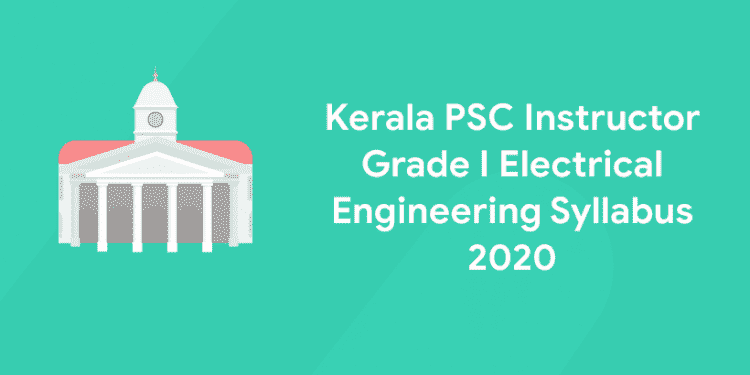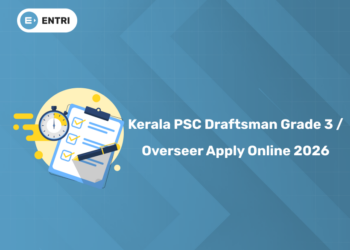Table of Contents
Kerala PSC has announced the exam dates for Instructor Grade I Electrical Engineering 2020 examinations for which the notification was released on 30-05-2017. The exam is scheduled to be held on December 2, 2020. For any competitive examination aspirants must be well aware of the syllabus and exam pattern. This will help you in drafting a very good study plan. With a proper study plan, guidance and hardwork one can easily crack any competitive exam. In this article we will provide the Kerala PSC Instructor Grade I Electrical Engineering Syllabus 2020.
Attempt free mock test for Kerala PSC LDC exam
Kerala PSC Instructor Grade I Electrical Engineering Syllabus 2020 – Important Details
| Name of Post | Instructor Grade I Electrical Engineering |
| Department | Technical Education (Engineering Colleges) |
| Scale of Pay | RS: 15600-39100/- (AICTE Pay band with AGP 5400) |
| Number of Vacancies | 1 |
| Category Number | 079/2017 |
| Educational Qualification | Bachelor’s Degree in appropriate branch of Engineering/Technology with anaggregate of 60% mark |
| Age Limit | 20 – 44 |
| Last date for online submission | 11.10.2020 |
| Date of Examination | 02.12.2020 Wednesday |
| Method of appointment | Direct Recruitment |
Kerala PSC Instructor Grade I Rural Engineering 2020 – Exam Pattern
1: Which Year First Assembly Election was held in Kerala?
- Exam Type: Objective Multiple Choice
- Mode of Examination: OMR/Online
- Total Marks: 100
- Total time duration: 1 Hour15 Minutes
Enroll in Kerala's Top-rated Kerala PSC Coaching Program!
സർക്കാർ ജോലി എന്ന സ്വപ്നം ഇനി സ്വപ്നം മാത്രമല്ല! Join Entri's Kerala PSC Coaching Programs
Join Now!Kerala PSC Instructor Grade I Electrical Engineering Syllabus 2020
Below given are the main topics that are included in the syllabus of Kerala PSC Instructor Grade I Electrical Engineering-
Part I (a) – Technical Mathematics
Part I (b) – Basic Civil Engineering
Part I (c) – Basic Mechanical Engineering
Part I (d) – Basic Electrical Engineering
Part I (e) – Essentials of Electronics Engineering
Part II – Electrical Engineering
Part I (a): Technical Mathematics
- Matrices – Identification of Matrices, matrix operations, adjoint and inverse.
- Determinants – Evaluation of second and third order, minors and cofactors, solutions of simultaneous linear equation in three unknown using Cramer’s rule.
- Binomial Series – Expansions using Binomial theorem.
- Trigonometric functions – Signs of functions in each quadrant. Trigonometric values of angles, properties of trigonometric functions, applications of the identities sin (A ± B), cos (A ± B) and tan (A ± B).
- Coordinate geometry – Equations to a straight line – slope-intercept form, intercept form, Angle between two lines, condition for two lines to be perpendicular, parallel.
- Differentiation – Limits and continuity, derivatives of functions, equation to tangents and normals. Maxima and minima of functions of one variable.
- Integration of functions – Integration of different types of functions.
- Applications of integration – Area bounded by a curve and X or Y axis, solutions of differential equations using the method of variable separable, solutions of linear differential equations of first order.
Download Entri & attempt free GK Quiz & ace exam preparation
Part I (b): Basic Civil Engineering
- Materials:
Brick – varieties and strength, characteristics of good brick. Cement – varieties and grade of cement and its uses. Steel – types of steel for reinforcement bars, steel structural sections. Aggregates – types & requirements of good aggregates. Concrete – grades of concrete as per IS code, water cement ratio. Workability, mixing, batching, compaction and curing.
- Construction:
Parts of building – foundation – types of foundations – spread footing, isolated footing, combined footing, Raft, pile and well foundations. Masonry – types rubble masonry, brick masonry, English bond and Flemish bond. (One brick wall).
- Surveying: Chain surveying – principles, instruments, ranging, and chaining survey lines, field work and field book, selection of survey stations, units of land area.
- Levelling: Levelling instruments, different types, bench mark, reduced level of points, booking of field notes, reduction of levels by height of collimation method (simple problem). Modern survey – instruments – Total station, Electronics theodolite, Distomat.
Part I (c): Basic Mechanical Engineering
- The importance of IC Engines:
Definition, classification – two stroke engines, four stroke engines, working of two stroke engines and four stroke engines with the help of line sketches, comparison between two stroke and four stroke engines, comparison between petrol and diesel engines, function of fly wheel, clutch, gearbox, propeller shaft and differential in power transmission, explain with sketch the working of differential, briefly explain power transmission of 4 wheel vehicle with line diagram.
- The importance of Power Plants: Introduction, classification of power plants – working of hydroelectric power plant with schematic sketches – working of thermal (Steam and Diesel) power plant with schematic sketches – working of nuclear power plant with schematic sketches.
Part I (d): Basic Electrical Engineering
- Review with discussion of electric current, potential difference, power, EMF, resistance and its laws, Ohms law and series parallel circuit, electromagnetism, generation of AC and DC supply.
- Idea of Basic electrical circuit:
Electrical supply and load and its functioning, division of voltage and current in a parallel and series circuit – simple problems, units of power and energy, solution of DC circuit with calculation of energy consumption in an installation.
- Circuit parameters:
Resistance, Capacitance and inductance. AC circuit with R, L, C. Simple solution of typical AC circuit with resistance, impedance, power and power factor.
- Electrical circuit of an installation: Earthing, lightning protection.
Part I (e): Essentials of Electronics Engineering
- Active and passive devices – review only. LED – working, applications, comparison of LED lighting and CFL lighting. Full wave rectifier – diagram and explanation, 5 V power supply – with bridge rectifier and 7805. SMPS – block diagram and advantages. Integrated circuits. SMDs – advantages. Static electricity – precautions in handling electronic circuits.
- Switches: ON / OFF, push to ON, push to OFF, push to ON / OFF, SPST, SPDT, DPDT. Working and application of limit switches, proximity switches, relays.
- Microcontrollers: Simple block diagram of 8 bit microcontrollers – application.
- Mobile technology: CDMA and GSM. Compare – 2G and 3G technologies.
- Inverter & UPS: Block diagram. Compare – inverter and UPS. Online and off line UPS – differentiate. Battery selection for UPS and inverter.
- E-waste: Health hazards of e-waste.
Part II – Electrical Engineering
Part II – (a)
DC machines – generator types, construction, emf equation, windings, characteristics armature reaction, commutation, trouble shooting and application.
DC motor – voltage equation, speed and torque, starting methods speed control, starters.
Transformer – single phase and three phase – equivalent circuits, phasor diagrams, tests, regulation and efficiency.
Connections – parallel operation, autotransformer – principle.
Induction motor – Squirrel cage and slip ring, principle and operation, slip, rotor current frequency and rotor emf. Torque equation, max torque, characteristics, power stages, equivalent circuits.
Speed control – starting methods, starters and applications.
Synchronous Generator – construction – salient pole & non salient pole, excitation – methods, emf equation, armature reaction, armature reactance, leakage reactance, Vector diagram, Voltage regulation, cooling system. Synchronous Motor – methods of starting, characteristic, application, Phaser, hunting.
Part II (b)
Power System: Power generation – system – hydel, thermal, nuclear, – layouts, site selection, advantages and disadvantages of different systems.
Transmission – line constants, line insulators, string efficiency, sag, skin, corona and Ferranti effect, DC transmission system.
Cables – terms and definitions. Types. Distribution – systems, overhead – Radial, ring & inter connected. Protection – primary and secondary, fuses – terms and definitions, types.
Circuit breaker – principle, operation and types. Protection of alternator, transmission line and neutral earthing. Utilisation electric heating, materials advantages, types, devices. Electrical welding principle and types, Traction, terms, definitions, speed time characteristic Breaking – types.
Part II (c)
Measurements & estimating: Instruments – Function, terms and definitions. Principle construction and application. Instruments used for current, voltage, power, power factor, frequency and energy. Digital voltmeter, digital multimeter, and cathode ray oscilloscope (CRO).
Transducers and gauges – stain gauge – LVDT, burden tube, capacitor transducer, Piezoelectric transducer, bellows,
Illumination – terms and definitions, laws of illumination lighting schemes, design and calculation. Lamps – different types – working. IS code, I E rule, busbar design. Industrial electrification.
Part II (d)
Electronics and Op-amp: Transistor – characteristics, configuration and application.
Amplifier – classification, working, circuit diagram and application.
Oscillator – concept of Barkhausen’s criteria, types.
Multi Vibrates – types circuit diagram and application.
Number system – conversion of decimal, octal and hexadecimal into binary and vice versa. Binary addition, subtraction and division.
Systems of signed binary number – true magnitude form, 1’s compliment, 2’s compliment.
Logic gates – basic logic gates – verification of Truth table – Boolean’s algebra – axioms and postulates, universal logical gates. K-Map, De Morgan’s theorem, half adder, full adder, multiplexing and demultiplexing. Flip flop circuit and clocked flip- flop circuits, operational amplifier – working characteristic and applications.
Part II (e)
Power Electronics and Microcontroller: UJT, FET, Diac, Triac, SCR – principle, construction, operation, characteristic, Electric Drives – DC, single phase, semi converter, single full converter single phase duel converter. Speed control of 3 phase induction, stator control, voltage and frequency.
Microcontroller – 8051 microcontrollers – features, block diagram, architecture, register structure, special function registers, internal and external memory, pin details, ports, counters and timers in 8052. Serial I/Os, associated registers, interrupts.
PLC – applications, importance, block diagram, operation types of PLCs, programming – methods – ladder diagram.
Download Entri & get free monthly current affairs capsule & ace exam preparation
Other Important Link:
Weekly English Vocabulary Based on The Hindu Editorial 2020 October 02
Kerala PSC Questions about Indian States in Malayalam
Kerala PSC Assistant Salesman Civil Supplies Previous Questions
How you can use Entri app for your exam preparation:
- Entri provides an online platform to help you prepare for competitive exams.
- Download for free of cost and get access to video classes, exams and study cards with a single subscription fee.
- You can access full length mock tests and previous year question papers and practice free monthly current affairs quiz.












